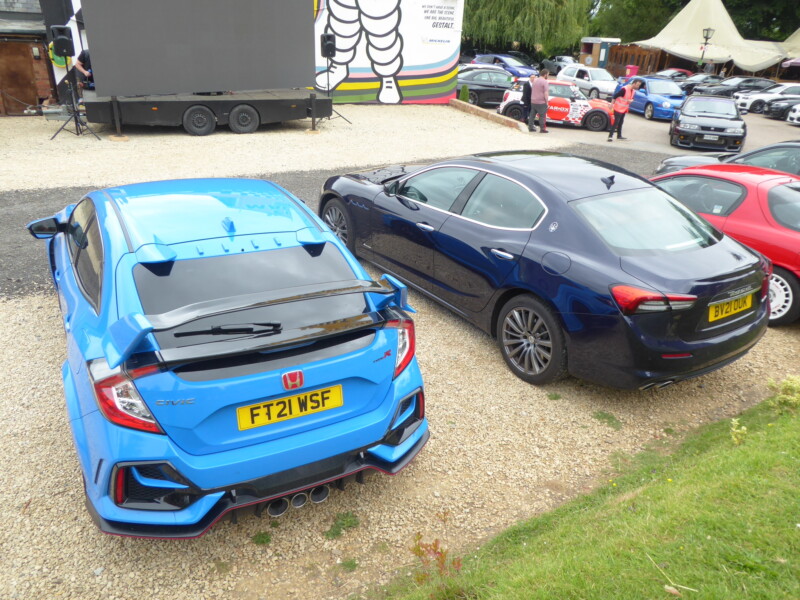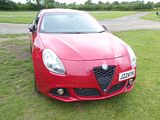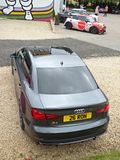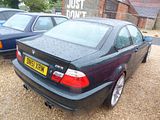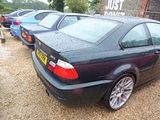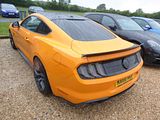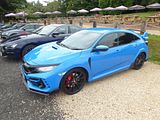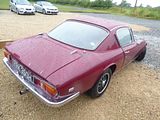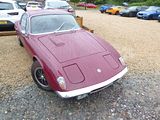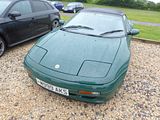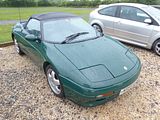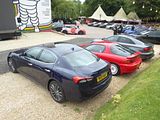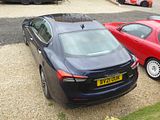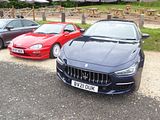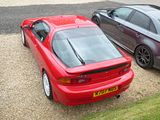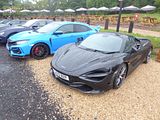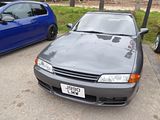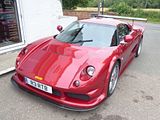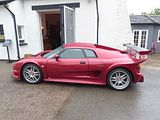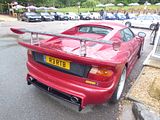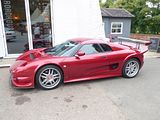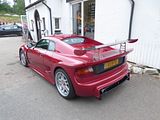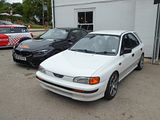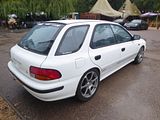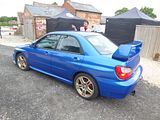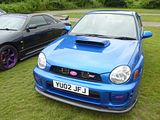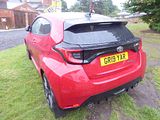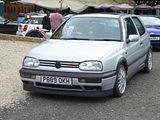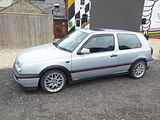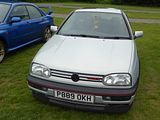Every visit to the renowned Caffeine & achine, and there have been many of them in my case, as previous reports on this site evidence, brings surprises. You never know quite what cars will turn up on any given day. Whilst weekends tend to be the busiest and represent your best chance to see everything from the latest exotica to largely forgotten classics and almost anything in between, I know from the various Facebook posts made by the venue itself and its visitors that weekdays can also yield some cars you were not expecting to see. Such is the popularity of the weekends, though, that a ticketing system had be brought in a long time ago, to ensure that anyone who turns up can actually get in to a site which does have a finite capacity. Summer weekends are especially popular and often sell out several days in advance, even before there is great certainty as to what the weather will bring. So when I made a relatively last minute decision to book in for the first slot on a Saturday morning at the start of July, I considered myself lucky still to be able to get a ticket. I duly arrived soon after 9am and there were indeed some nice cars parked up. I looked forward to a whole load more turning up. But this was a July day that felt more like early April – cold and with a menacing looking sky and those additional cars just did not arrive. Having grabbed some photos of the cars that were there, which did not take all that long, I ordered a warming cup of coffee, installed on a seat under cover which gave me the perfect view of what else was coming onto site. The coffee arrived, but the cars, by and large did not. And then it started to rain. And the sky suggested it might not stop. Whilst I could stay dry where I was sitting, and I could take full advantage of sitting in front of a massive tv screen that was set up in front of the building, ready to broadcast all the action from Silverstone over the weekend, it was not particularly warm sitting there. I figured I could actually move to my car and still see the screen – and such was the sound volume that I could also hear the commentary without having to lower the windows, and so that is what I did. An hour or so on, though, when it was clear that no more cars were likely to arrive, I decided it was time to leave and head to my next destination, slightly disappointed, and yes, indeed surprised once by Caffeine & Machine. So here are the cars which I felt warranted a photo or two whilst I was on site:
ALFA ROMEO
The Alfa Romeo MiTo (Type 955) is a front-wheel drive, three-door supermini designed by Centro Stile Alfa Romeo and presented in 2008 at Castello Sforzesco in Milan with an international introduction at the British Motor Show in 2008. The new car was provisionally named the “Junior”. In November 2007, Alfa Romeo launched a European public naming competition; the winner from each country to win an Alfa Romeo Spider or an Alfa Romeo mountain bike. The winning name was “Furiosa”, which scored well in Italy, France, United Kingdom and Germany, but not in Spain. In 2008, Alfa Romeo announced “MiTo” as the official name, a portmanteau of Milano (Milan) & Torino (Turin), because it was designed in the former and was assembled in the latter. The name is also a play on the Italian word “mito”, meaning “myth” or “legend”. The MiTo is front-wheel drive, with a system allowing the driver to choose three driving settings: Dynamic, Normal, and All-Weather. The system, marketed as “Alfa DNA,” tunes the behavior of the engine, brakes, steering, suspension and gearbox. The MiTo also features LED tail lights and 250-litre (8.8 cu ft) of luggage space. The MiTo also features a Q2 electronic differential on the front wheels, which is active with the DNA switch in Dynamic position, and allows for faster and tighter cornering without loss of traction. In 2010 a new transmission for the MiTo was unveiled at the 2010 Geneva Motor Show, the six-speed TCT which is produced by Fiat Powertrain Technologies in Verrone (TCT Dual Dry Clutch Transmission). Magneti Marelli delivers the control system which integrates BorgWarner’s hydraulic actuation module into its own power and transmission control units. It can handle torque inputs of up to 350 N⋅m (258 lbf⋅ft) In Geneva was also unveiled Blue&Me–TomTom, this new system integrates TomTom navigation to the Blue&Me infotelematic system. At its launch the MiTo featured low-displacement turbocharged petrol and diesel engines. Also, a power limited 78 bhp naturally aspirated engine variant is produced to meet the new Italian legislation for young people. MiTo got new electro-hydraulic valve control system Multiair engines from September 2009. MultiAir engines will increase power (up to 10%) and torque (up to 15%), as well as a considerable reduction in consumption levels (up to 10%) and CO2 emissions (up to 10%), of particulates (up to 40%) and NOx (up to 60%). This new engine is available with 104 bhp,133 bhp and 168 bhp power ratings. All multiair versions have start-stop system as standard. In October 2009 was unveiled a dual fuel MiTo version, this version can run with LPG (Liquefied petroleum gas) or petrol, with this engine MiTo has range of 1,200 km (750 miles). The LPG version is made in collaboration with Landi Renzo. In Summer 2010 Alfa introduced the Dual Dry Clutch Transmission called Alfa TCT ( i.e. Twin Clutch Transmission ). From model year 2011 the start-stop system came as standard on all versions. At the 2011 Frankfurt Motor Show, AR introduced two new engines for the MiTo – The 0.9 L I2 TwinAir and a new low emission 85 PS version of the 1.3 JTD diesel engine. The Quadrifoglio Verde (green four-leaf clover) has traditionally been the highest line of Alfa Romeo models. The car (see Alfa Romeo in motorsport article for the history of this emblem) version of Mito was presented at the 2009 Frankfurt Motor Show. The QV version has the new 1.4 litres (1,368 cc) Turbo Multiair inline-four engine 168 bhp at 5500 rpm and 250 Nm (184 lb/ft) of torque at 2500 rpm, with newly engineered suspension, steering and new six-speed C635 gearbox developed by Fiat Powertrain Technologies (FPT). Its specific output of 124 PS per litre was highest in its segment at that time. The new multiair technology allows fuel consumption of 6 l/100 km (47 mpg) in EU combined driving and CO2 emissions of 139 g/km. QV had bigger 305 mm front brake discs and exclusive 18″ alloy wheels as standard and Sabelt carbon fibre backed bucket seats as an option. From 2014 QV was now available with TCT robotised gearbox which brought down the 0–100 km/h time to 7.3 s. With the 2016 facelift, the QV was renamed as the Veloce. For model year 2014, the MiTo got a new 105 PS 0.9 L Turbo TwinAir engine, new chrome-plated grille, new Anthracite grey colour and new burnished front light clusters. The car interior was also updated with new upholsteries, three new dashboards looks, as well as the new Uconnect 5.0 infotainment systems. The engine range now consists two turbo diesel engines (the updated E5+ 85 PS 1.3 L JTDM and the 120 PS 1.6 L JTDM) and five petrol engines: the 70 PS 1.4, the 78 PS 1.4, the 135 PS 1.4 MultiAir Turbo (with manual or Alfa TCT Dual Dry Clutch Transmission) and the 170 PS 1.4 MultiAir Turbo. The range has also 120 HP 1.4 LPG Turbo option. Debuting at the 2016 2016 Geneva Motor Show, the revised Mito featured a facelifted front fascia with a new updated brand logo and new lettering. Trim line up was changed to Mito, Super and Veloce. A new body colour and new rims designs also became available. The previous MiTo QV became the Mito Veloce, available with 170 PS engine and TCT transmission. The MiTo was marketed across a single generation from 2008 to 2018, sharing the Fiat Small platform with the Fiat Grande Punto. Production reached 293,428 at FCA’s Mirafiori plant.
AUDI
Launched shortly after the regular A3 models, the third generation Audi S3 is powered by a 1,984 cc TFSI (turbo petrol direct injection) inline-four engine, with an output of 300 PS (296 bhp) at 5,500 rpm and 380 Nm (280 lb/ft) of torque at 1,800-5,500 rpm, with its redline at 6,800 rpm. It features new pistons with stronger bolts and new rings, as well as reinforced connecting rods with new mounts transferring the power to the crankshaft. The cylinder head is made of a new lightweight aluminium alloy designed with high strength and temperature resistance in mind. It has a combined fuel economy of 10.0 L/100 km (28 mpg‑imp) manual; and 9.8 L/100 km (29 mpg‑imp) with S tronic. The engine weighs in at 148 kg (326 lb), 5 kg (11 lb) lighter than the previous generation. The S3 is capable of 0–100 km/h (62 mph) in 4.8-5.2 seconds and has an electronically limited top speed of 155 mph (249 km/h). Thte S3 was engine was offered with all four of the different bodies: 3 and 5 door hatch, the cabio and as seen here, the saloon.
BMW
The BMW E30 is the second generation of BMW 3 Series, which was produced from 1982 to 1994 and replaced the E21 3 Series, and was the car which really saw the popularity of the 3 Series increase dramatically. . Development of the E30 3 Series began in July 1976, with styling being developed under chief designer Claus Luthe with exterior styling led by Boyke Boyer. In 1978, the final design was approved, with design freeze (cubing process) being completed in 1979. BMW’s launch film for the E30 shows the design process including Computer-aided design (CAD), crash testing and wind-tunnel testing. The car was released at the end of November 1982. Externally, the E30’s appearance is very similar to twin headlight versions of its E21 predecessor, however there are various detail changes in styling to the E30. Major differences to the E21 include the interior and a revised suspension, the latter to reduce the oversteer for which the E21 was criticised. At launch, the car had a 2 door style like its predecessor and just four engines, all of them petrol: the 316 and 318 four cylinder units and the 320 and 323i 6 cylinders. This last was soon upgraded to a 2.5 litre unit. Diesel models were added during the 80s and there was an all-wheel drive 325iX option for continental European markets. In addition to the 2 door saloon and Baur convertible body styles of its E21 predecessors, the E30 became available by early 1984 as a four-door sedan and later a five-door station wagon (marketed as “Touring”). The Touring body style began life as a prototype built by BMW engineer Max Reisböck in his friend’s garage in 1984 and began production in 1987. The factory convertible version began production in 1985, with the Baur convertible conversions remaining available alongside it. Following the launch of the E36 3 Series in 1990, the E30 began to be phased out.
The M3 version of the E46 3 Series was produced in coupé and convertible body styles. The E46 M3 is powered by the S54 straight-six engine and has a 0-100 km/h (62 mph) acceleration time of 5.1 seconds for the coupe, with either the manual or SMG-II transmission. The skid pad cornering results are 0.89 g for the coupe and 0.81 g for the convertible.The top speed is electronically limited to 250 km/h (155 mph). The available transmissions were a Getrag 420G 6-speed manual transmission or a SMG-II 6-speed automated manual transmission, which was based on the Getrag 420G. The SMG-II used an electrohydraulically actuated clutch and gearshifts could be selected via the gear knob or paddles mounted on the steering wheel. The SMG-II was praised for its fast shift times and racetrack performance, but some people found its shifts to be delayed and lurching in stop-start traffic. In 2005, a special edition was introduced which used several parts from the CSL. This model was called the M3 Competition Package (ZCP) in the United States and mainland Europe, and the M3 CS in the United Kingdom. Compared to the regular M3, the Competition Package includes: 19-inch BBS alloy wheels- 19″x 8″ at the front and 19″x 9.5″ at the rear; Stiffer springs (which were carried over to the regular M3 from 12/04); Faster ratio steering rack of 14.5:1 (compared with the regular M3’s ratio of 15.4:1) as per the CSL; Steering wheel from the CSL; M-track mode for the electronic stability control, as per the CSL; The CSL’s larger front brake discs (but with the regular M3 front calipers) and rear brake calipers with larger pistons; Alcantara steering wheel and handbrake covers; The engine, gearbox and other drivetrain components are the same as the standard M3. Total production of the E46 M3 was 56,133 coupes and 29,633 convertibles. The cars were assembled at the BMW Regensburg factory in Germany and production was from September 2000 until August 2006, production totalled 85,766.
Final BMW of note here was the recently superceded M4.
FORD
In 2005 Ford unveiled a hot hatch version of the Mk 2 Focus. Called Focus ST, and available in either three or five-door hatchback variant, the car uses the Volvo Modular engine, a turbocharged 2.5 L 5-cylinder engine producing 225 bhp. Ford however rebadged it as the Ford Duratec ST, applied variable valve timing to both camshafts, applied a lighter flywheel and performed a throttle recalibration. The Ford Focus Mk 2 ST is also known as the XR5 Turbo in the Australian and New Zealand market, but is sold as a five-door hatchback only. In 2008 Ford, in conjunction with Mountune Racing, unveiled a power upgrade kit which raises the power output to 260 bhp the kit consists of: a K&N panel filter, larger intercooler and a re-map. Although the platform is the same, no saloon version was ever released. Sales ceased when the third generation Focus was released in 2011.
The other Ford of note was a Mustang GT. This generation of Mustang is the first to be sold as a new car in right hand drive form in the UK and it has proved quite popular, with sales of the V8 being greater than was perhaps expected.
HONDA
The Civic Type R Prototype was unveiled in September 2016 at the Paris Motor Show, and the production version unveiled at the 2017 Geneva Motor Show. The new car builds on Honda’s heritage in developing high-performance hatchbacks. The design is based on the Civic Hatchback, with a winged carbon fiber effect splitter with red accent line, slatted ducts, diamond-mesh air intakes, red ‘H’ badge above a new air vent at the nose of the car, new air intake on the hood, an air scoop sited centrally in a trapezoidal recess, smoked lenses for the LED headlights, indicators and side repeaters, carbon fibre effect side skirts, 20-inch piano black alloy wheels with red accents, 245/30 R20 high-performance tires, enlarged wheel arches, a carbon fiber effect diffuser which runs below the wider rear bumper, 3 tailpipes with a pair of directional strakes at each side, central tailpipe in bright metallic red and unique peaks at the roof flanks that point backward. The FK8 Civic Type R uses the same engine from its predecessor, a turbocharged inline-four with increased power to 320 PS (235 kW; 316 hp) in the European and Japanese version but remains the same 310 PS (306 bhp) in other markets. The engine is mated to a close-ratio 6-speed manual transmission continuing the tradition of its predecessors with limited-slip differential as standard. The aerodynamic elements increase downforce even further as compared to the outgoing model. The FK8 has a top speed of 272 km/h (169 mph) making it the fastest Civic Type R model to date. In back-to-back testing involving an FK8 and FK2 Type R, the reviewers praised the FK8’s comfortable ride and feedback and criticised the FK2’s harsh ride on the road and worse handling when the R+ driving mode was activated. The reviewers also complained about the FK2’s interior being dated but stated that this was due to the model’s late arrival at the end of the base model’s production run The interior of the Type R is based on the base model Civic and has a low driving position with the gear shift lever positioned high in order to allow for easy gear changes. The interior has red and black color as standard with sports seats along with faux carbon fibre trim. The driver’s seat and the steering wheel are adjustable. A reversing camera is standard for easier rear visibility while reversing while parking sensors are standard in the GT Trim. The interior although lauded for its comfortability and user-friendliness is criticised for its infotainment system which has been described as slow and difficult to operate. The fit and finish are considered to be comparable with its competitors. Safety features include automatic emergency braking, traffic sign recognition, lane departure warning and automatic high beam assistance which are carried over from the base Civic. The GT trim adds blindspot monitoring and cross-traffic alert, parking sensors at the front and rear, dual-zone climate control, power-folding door mirrors and infotainment upgrades that include wireless phone charging and in-built sat-navigation along with a more powerful 11-speaker stereo. The Type R earned a Euro NCAP 5 star crash test rating. On 3 April 2017, the pre-production Type R achieved a lap time of 7:43.80 on the Nürburgring Nordschleife, almost 7 seconds faster than its predecessor, setting a new record for front-wheel drive cars. The car also set new front-wheel drive lap records at the Magny-Cours, Spa-Francorchamps, Silverstone, Estoril, Hungaroring and Mount Panorama circuits. The Nürburgring record was broken by the Renault Mégane RS Trophy-R in July 2019 which set a time of 7:40.10, but in 2020 the Limited Edition Civic Type R broke the Mégane’s front-wheel drive lap record at the Suzuka Circuit by one and a half seconds. Production ceased in 2022.
JAGUAR
The F Type has been on sale for several years now, with a surprising number of different versions of both the Coupe and the Convertible having been produced with a mix of 4, V6 and V8 cylinder engines. A facelift, which divides opinions in terms of the visual changes it introduced, came in early 2020. There was one example of the model here.
LOTUS
Introduced in 1967, the Elan +2 had a longer wheelbase and two rear seats and so was intended for those Lotus customers who needed space to carry (small) people in the back, without sacrificing the same basic principles which made the Elan so appealing. A fast and agile sport coupe, a number of different engines were fitted over the years, with the later models having 130 bhp and a 5 speed gearbox at their disposal, which gave a top speed of 120 mph and 0–60 acceleration of 7.9 seconds and 0-100 mph 21.8 seconds. 5,200 Elans +2 were made, with production ceasing in 1975. Fewer than 1,200 of these cars remain on the roads today. Their relative rarity, beautiful lines, impressive performance and practicality are the main factors for the rising interest on these cars among collectors.
There has only ever been one front wheel drive model with Lotus badges on it, the “M100” Elan sports car. Like many specialist produced cars of the era, there was a long wait for this car form when news first broke that it was under development to the actual release of cars people could buy. The M100 Elan story goes back to 1986 and the purchase of Lotus by General Motors which provided the financial backing to develop a new, small, affordable car in the same spirit as the original Elan, the last of which had been built in December 1972. A development prototype, the M90 (later renamed the X100) had been built a few years earlier, using a fibreglass body designed by Oliver Winterbottom and a Toyota-supplied 1.6-litre engine and transmission. Lotus was hoping to sell the car through Toyota dealerships worldwide, badged as a Lotus Toyota, but the project never came to fruition and the prototype was shelved, although Lotus’s collaboration with Toyota had some influence on the design of the Toyota MR2. The idea of a small roadster powered by an outsourced engine remained, however, and in late 1986 Peter Stevens’s design for the Type M100 was approved and work began by Lotus engineers to turn the clay styling buck into a car that could be built. This process was completed in just under three years, a remarkably short time from design to production car. The M100 Elan was conceived as a mass-market car and in particular one that would appeal to US buyers. Consequently, Lotus put an enormous effort (for such a small firm) into testing the car; over a two-year period 19 crash cars and 42 development vehicles were built, logging nearly a million test miles in locations from Arizona to the Arctic. The Elan was driven at racing speeds for 24 hours around the track at Snetterton. Finally each new car was test-driven for around 30 miles at Lotus’s Hethel factory to check for any manufacturing defects before being shipped to dealers. The choice of front-wheel drive is unusual for a sports car, but according to Lotus sales literature, “for a given vehicle weight, power and tyre size, a front wheel drive car was always faster over a given section of road. There were definite advantages in traction and controllability, and drawbacks such as torque steer, bump steer and steering kickback were not insurmountable.” This was the only front-wheel-drive vehicle made by Lotus. Every model made since the M100 Elan, such as the Lotus Elise, has been rear-wheel drive. The M100 Elan’s cornering performance was undeniable (on release the Elan was described by Autocar magazine as “the quickest point to point car available”). Press reaction was not uniformly positive, as some reviewers found the handling too secure and predictable compared to a rear-wheel-drive car. However, the Elan’s rigid chassis minimised roll through the corners and has led to its description as ‘the finest front wheel drive [car] bar none’. Unlike the naturally aspirated version, the turbocharged SE received power steering as standard, as well as tyres with a higher ZR speed rating. The M100 Elan used a 1,588 cc double overhead camshaft (DOHC) 16-valve engine, sourced from the Isuzu Gemini and extensively modified by Lotus (a third generation of this engine was later used in the Isuzu Impulse), which produced 162 hp. 0–60 acceleration time was measured by Autocar and Motor magazine at 6.5 seconds, and a top speed of 137 mph was recorded. Significant differences in the Isuzu-Lotus engine from the original include a new exhaust system, re-routed intake plumbing for better thermodynamic efficiency, improved engine suspension, and major modifications to the engine control unit to improve torque and boost response. Almost all models featured an IHI turbocharger. Two variants were available at launch, the 130 bhp Elan 1.6 (retailing at £17,850) and the 162 bhp Turbo SE (£19,850). Initial sales were disappointing, perhaps because its launch coincided with a major economic recession in the UK and USA, and perhaps also because it coincided with the cheaper Mazda MX-5 which was arguably similar in concept, though the MX-5 was quite intentionally nostalgic and old fashioned (apeing the original Elan), while the M100 was deliberately futuristic, modern and forward looking. The Elan was regarded as a good product in a bad market, but was also very expensive to make (the cost to design and produce the dashboard alone was more than the total cost of the Excel production line), and sales figures were too low to recoup its huge development costs. Altogether 3,855 Elans were built between November 1989 and July 1992, including 129 normally aspirated (non-turbo) cars. 559 of them were sold in the US, featuring a ‘stage 2 body’ which had a different rear boot spoiler arrangement together with a lengthened nose to accommodate a USA-compliant crash structure and airbag, and 16-inch wheels (optional in most markets, standard in the U.S.) instead of 15-inch as on the UK model. A limited edition of 800 Series 2 (S2) M100 Elans was released during the Romano Artioli era (produced June 1994–September 1995) when it was discovered that enough surplus engines were available to make this possible. According to Autocar magazine, the S2 addressed some of the concerns over handling, but power was reduced to 155 bhp and the 0–60 acceleration time increased to 7.5 seconds, due to the legislative requirement to fit a catalytic converter in all markets. The S2s have very similar performance to the USA vehicles, having an identical engine management system calibration and a slightly lower overall vehicle weight.
MASERATI
Sole Maserati here was my Ghibli.
MAZDA
The Mazda MX-3, a small four-seat coupé, was introduced at the Geneva Auto Show in March 1991 and was produced until 1998. The MX-3 was also marketed as the Mazda MX-3 Precidia in Canada and as the Eunos Presso, Autozam AZ-3 and Mazda AZ-3 in Japan. In Australia it was marketed as the Eunos 30X until late 1996 when it became the Mazda-Eunos 30X. The MX-3’s platform is called the EC platform, and shares much with the BG platform of the contemporary Familia/323/Protegé. The first model year available for most markets, including North America where it went on sale in September 1991, was 1992. Originally available with a single-cam 1.6-liter inline-four or the twin-cam V6, a few more engines were available as development continued. In the summer of 1991, the Autozam AZ-3 was added to the Japanese market lineup. It was known by two names;”Autozam” was meant to be Mazda’s more youthful brand, so it combined a somewhat lower price with a sportier (but smaller) twin-cam four of 1.5 liters, and also sold as the Eunos Presso, a companion, affordable sports car to the Eunos Roadster. The small displacement V6 was offered to comply with Japanese government regulations concerning exterior dimensions and engine displacement; Japanese buyers were liable for annual taxes for vehicles exceeding the regulations and large displacement engines, which would affect sales. Japanese buyers who were willing to pay the tax for larger vehicles were now given a choice of the FC series Mazda RX-7 and the JC series Mazda Cosmo. In January 1994, a DOHC version of the familiar B6 engine, the B6D, replaced the previous version. This provided a useful power increase but conversely also made the considerably more expensive V6 version less desirable. Sales of the V6 in the United States market came to an end after the 1994 model year, although they continued in Canada, Japan and many other export markets. While called K8-DE in North American specs, Japanese and other markets received an engine called the K8-ZE. Aside from emissions equipment and varying power claims due to myriad ratings methods, the differences are negligible. The V6 MX-3 has a factory claimed top speed of 202 km/h (126 mph) in European trim. The US-spec MX-3 GS can accelerate from 0 to 60 mph in 8.4 seconds, and can travel a quarter mile in 16.4 seconds. With a turning rate of 0.89 g (8.7 m/s²), its handling capabilities were among the best in its class. The V6 engine belonged to the Mazda K-series, which were used in a range of Mazda vehicles. These engines use a Variable Length Intake Manifold (VLIM), in order to provide optimal torque using intake resonance. Mazda called their system on the MX-3 the “Variable Resonance Induction System” (VRIS). This engine had a 7,000 rpm redline, and a 7,800 rpm fuel cutoff. For the rear suspension of the MX-3, Mazda used its proprietary Twin-Trapezoidal Link (TTL) technology, delivering benefits associated with active four-wheel steering systems while lighter and less mechanically complicated. Twin-Trapezoidal Link technology has been used on a range of other Mazda vehicles before and since the MX-3. Although the car was quite well received, it did not sell in significant numbers and there was no direct replacement.
McLAREN
The 720S – a complete replacement for the 650S – was a star of the 2017 Geneva Show, and it was clear on looking at it, that the Woking firm really is increasingly a serious threat to Ferrari’s supercar supremacy, even before learning that total sales in just five years of production had passed 10,000 units. The 720S was presented as the firm’s new core model and the first of 15 new-generation McLarens, half of which will be hybrids, promised by 2022 under CEO Mike Flewitt’s ambitious Track 22 development plan. The 720S obeys all existing McLaren design rules. It is a two-seat supercar based on an all-carbonfibre tub, with aluminium space frames carrying the front and rear suspension, and it is powered by a twin turbo V8. However, within that envelope, it has been redesigned and updated in every detail. The exterior introduces a new ‘double skin’ door construction that eliminates the need for the prominent side air scoops previously thought essential in supercar design, while the engine grows to 4.0 litres, up from 3.8-litres, and now produces 710bhp. McLaren has further developed its carbonfibre chassis tub and upper structure, taking lessons from previous models, including the P1. Now dubbed Monocage II, the structure is cited as the key to the 720S’s 1283kg dry weight, which undercuts all competitors and beats that of its predecessor by 18kg. Monocage II’s stiffness has allowed McLaren’s designers to give the 720S remarkably thin A-pillars, a deep windscreen, B-pillars set well back and slim, glazed C-pillars, all of which contribute to first-class all-round visibility for the driver. The body panels are made either of carbonfibre or superformed aluminium, and their novel shape plays a key role in the 720S’s impressive aerodynamic performance. Low down at the front there are anti-lift aero blades reminiscent of those on the P1, while ultra-compact LED headlights fit into frontal ‘eye sockets’ that allow room for vents to feed the air conditioning and oil cooler. The body sides incorporate channels, formed by two skins and flowing past the dihedral doors, so cooling air can be directed along the body into the engine bay, uninterrupted by turbulence and resulting in a 15% improvement in cooling airflow. On the outer, lower part of the doors, there are F1-inspired blades that direct air away from the front wheel arches, assisting downforce and cutting drag. A big under-body diffuser at the rear sweeps up from the 720S’s flat floor almost to its rear wing, where the two elements frame the ultra-thin LED tail-lights. Because the top of the 720S’s engine is a remarkable 120mm lower than that of the 650S, the car also has a low, teardrop-shaped engine cover that allows an uninterrupted flow of air over the roof to the hydraulically actuated rear wing, which has a DRS drag reduction setting for optimal straight-line performance, an Aero setting for downforce in corners and a Brake setting (which sets the wing a steep 56deg from the horizontal) to increase drag and improve chassis balance under heavy braking. The result, says McLaren, is that the wing has 30% more downforce and its aero efficiency (the ratio of downforce to drag) is doubled. McLaren claims “new heights of performance” from its expanded turbo V8, now re-engineered for a capacity of 3994cc, thanks to a 3.6mm lengthening of its stroke. The engine also has lighter pistons and conrods and a stiffer, lightened crank, plus twin-scroll turbochargers with faster-spooling turbines, capable of spinning at 145,000rpm, and electronically controlled wastegates. In total, 41% of the engine’s components are new. A cast aluminium air intake system, visible through the mesh engine cover, feeds extra air to the more potent engine that now uses two injectors per cylinder. But rather than simply pumping in more fuel, the improved injection system gives more accurate metering, which helps to cut CO2 emissions by around 10%, to a class-leading 249g/km. Combined economy falls by a similar percentage to 26.4mpg. The 720S’s peak output of 710bhp is produced at 7000rpm, while maximum torque of 568lb ft is delivered at 5500rpm. The engine, longitudinally mounted behind the occupants, drives as before through a seven-speed dual-clutch automatic gearbox mounted end-on to the engine, but McLaren says further refinement of its control software brings smoother gearchanges at low speeds and faster, sharper shifts at higher speeds. The launch control has also been improved, and as before, there are three driving modes — Comfort, Sport and Track — that govern both engine and dynamics. The chassis weight savings, allied to other reductions in mass, including 2kg from the brakes, 3kg from the electrics and 1.5kg from the airboxes, contribute as much to the 720S’s enhanced performance as its 11% power increase. The power-to-weight ratio is now 553bhp per tonne (up 15%) and, according to McLaren, beats the best in the segment. As a result, McLaren claims a “crushing” 0-60mph time of just 2.8sec, 0-124mph in 7.8sec and a top speed of 212mph. The 720S will also dispatch a standing quarter-mile in 10.3sec, representing a blistering performance for a pure road car. To accompany the performance, the 720S has a carefully engineered engine note which can be further enhanced with an optional, louder, sports exhaust system. Despite its performance potential, McLaren is adamant that its new car is as easily handled by ordinary drivers as it is by experts, with throttle response calibrated to provide “the optimum blend of immediate reaction and progressive comfort”. Although only five years old, McLaren’s all-independent system of front and rear double wishbones has been completely re-engineered, both to allow wheel geometry changes and, thanks to a redesign of the uprights and wishbones, to cut unsprung mass by 16kg. The 720S has an updated version of the Proactive chassis control electronics used by the 650S. The system features hydraulically interlinked dampers at each corner that remove the need for anti-roll bars, but the big improvement for the 720S’s system, which is dubbed PCCII, results from new software developed during a six-year collaboration with the University of Cambridge and using sophisticated information gathered by 12 new sensors and accelerometers. The result is even better contact between the tyres and the road surface. The system can assess conditions and adjust the suspension every five milliseconds. It also includes a Variable Drift function, which allows you to slide the car without losing control, and McLaren Brake Steer, pioneered in F1, which enhances agility in corners and traction out of them by braking separate wheels. McLaren engineers have retained electro-hydraulic steering for the 720S, despite rivals’ adoption of electric only systems, because they still feel it gives superior “clarity of feel”. Brakes are large, ventilated carbon-ceramic discs and the tyres are specially developed Pirelli P Zeros, 245/35 ZR19s at the front (up from the 650S’s 235s) and 305/30 ZR20s at the rear. McLaren claims a 6% increase in mechanical grip, which is about the same advantage as fitting track-focused Pirelli Corsas to a 650S. Although the 720S closely follows the outgoing 650S in its major dimensions, there are differences between them. The thin pillars, the depth of the windscreen and the all-round glass give a commanding view to all points that modern supercar drivers will find surprising. The redesigned interior surfaces have been ‘pushed away’ from the occupants as much as possible, to further enhance the feeling of space. Unlock the door and various instrument and courtesy lights go through a welcome sequence as the mirrors unfold. Opening the door also triggers an elaborate sequence on the upright TFT screen which changes its configuration according to driving mode. The driver can also ‘declutter’ the instruments, for example when on a track, via a special Slim mode. There’s a central 8.0in infotainment screen on the centre console, with ventilation settings carried along the bottom. The layout of switches, most of which are machined from aluminium, is simple. Standard cabin trim and seats are plush but, as with previous models, colour and trim material upgrades are available. McLaren has already begun taking orders, with the first cars due to be delivered in May. The entry price in the UK was £207,900. All 400 units of the Launch Edition version were sold even before the general public saw the car though many of these then hit the pre-owned market quite quickly, traded in once owners could take delivery of a car in the spec that they really wanted. McLaren’s goal is to sell around 1200 – 1500 720S models a year.
NISSAN
This is an R32 generation Skyline, which debuted in 1989. It was available as either a 2-door coupe or 4-door hardtop sedan, all other bodystyles were dropped. The R32 featured several versions of the RB-series straight-6 engines, which had improved heads (the twelve port inlet was gone) and used the ECCS (Electronically Concentrated Control System) injection system. Also available was an 1,800 cc 4-cylinder GXi model. Most models had HICAS four-wheel steering, with the rear wheels being hydraulically linked to the front steering. The 2.5-litre GTS-25 became one of the first Japanese production cars to feature a 5-speed automatic transmission. The GTS-t came in standard and Type M configurations, with the Type M having larger five-stud 16-inch wheels, four piston front callipers and twin piston rears plus other minor differences. ABS was optional (except for the GT-R and GTS-4), mechanical LSD was standard on the GTR and viscous LSD was standard on all turbo models and optional on all but the GXi. Nissan also produced 100 Australian models of the R32. In addition, there was a 4WD version of the GTS-t Type M, called the GTS-4. This generation was considered a “compact” under Japanese legislation that determined the amount of tax liability based on exterior dimensions. The smaller engines were offered so as to provide Japanese buyers the ability to choose which annual road tax obligation they were willing to pay. The station wagon bodystyle was discontinued, and replaced by the Nissan Stagea. 296,087 of these cars were sold in its five year production run.
NOBLE
Follow on to the Noble M10, the M12 was a two-door, two-seat model, originally planned both as a coupe and as a convertible. All M12s were powered by modified bi-turbocharged Ford Duratec V6 engines. There was a full steel roll cage, steel frame, and G.R.P. (fibreglass) composite clam shell body parts. Although looking to be track derived, the M12 was street-legal, ready for both road and track. The M12 has no anti-roll bars on the car, allowing for a comfortable feel. The coupe evolved through four versions of Noble cars, with the 425 bhp M400 as the ultimate version of the M12, following the first 2.5 litre 310 bhp car, the 352 bhp 3 litre GTO-3 and the GTO-3R. The car was sold in the US, where it proved quite popular, with 220 GTO-3Rs and M400s sold there. US production rights were sold in February 2007 to 1G Racing from Ohio. Due to high demand of these cars, 1G Racing (now Rossion Automotive) released its own improved car based on the M400, named Rossion Q1. Another company which is also producing a model developed from the M12 is Salica Cars 1 with their Salica GT and Salica GTR.
SUBARU
Announced on 22 October 1992, the Impreza was released in Japan in November and offered in either front-wheel drive (FWD) or all-wheel drive (AWD) versions and as a four-door sedan or five-door wagon (Touring). The car used a shortened version of the Legacy’s floor pan. According to a Motor Trend article written March 1992 on page 26, the name of Subaru’s new compact was, initially, to be called the Loyale, displaying an official photograph of the four-door sedan. In late 1995, a two-door coupe was introduced. In Japan it was called Impreza Retna. Initial engine choices included 1.5, 1.6, 1.8, and 2.0-litre naturally aspirated engines. Subaru chose to continue their longstanding use of the boxer engine in the Impreza. According to Subaru, their configuration of the engine inline with the transmission minimizes body roll due to the lower center of gravity compared with offset engines in most other vehicles. The boxer design provides good vibration mitigation due to the principles of a balanced engine because the movement of each piston is largely countered by a piston in the opposing cylinder bank, eliminating the need for a counter-weighted rotating crankshaft (harmonic balancer), but with some vibration from offsets. Torque steer is also reduced with this type of powertrain layout since the front drive shafts are of equal length and weight. At the time of introduction, the Japanese and European market naturally aspirated models (1.6 and 1.8) received an unusual grille with a small central opening. Only the WRX and regular North American models received a conventional “full” grille until the 1994 facelift, when the regular models’ appearance was brought in line with that of the sporting models. Trim levels were LX, GL and Sport generation. LX models were front-wheel drive, and powered by a 1.6-litre engine. GL trim levels were either front-wheel drive (Subaru badged these 2WD) or all-wheel-drive (badged AWD); cars launched in 1993 had a choice of 1.6- and 1.8-litre flat-4 engines, the 1.6 being available with 2WD, the 1.8 an AWD version only. From 1996, the 1.8-litre versions were dropped (in the European market), and replaced by a 2.0-litre engine. Sport versions had alloy wheels, and a 2.0-litre engine only. The Impreza received an external facelift for the 1997 model year, followed by an interior redesign in 1998, using the new redesigned dashboard from the Forester. In Europe the Turbo and later WRX and STi models gained increasing significance in the range and these are the cars you see most often now, so this was a rare spot.
Subaru introduced the “New Age” Impreza, the second generation car, to Japan in August 2000, and it arrived in Europe towards the end of that year. Larger in size compared to the previous iteration, the sedan increased its width by 40 millimetres (1.6 in), while the wagon notably increased by just 5 millimetres (0.2 in)—placing the two variants in different Japanese classification categories. The coupe body style from the first generation did not reappear for the new series, and the off-road appearance package that included contrasting-coloured bumpers did carry over forward. Marketed as a separate model line, this North America-only variant was, as before, badged the Outback Sport. Naturally aspirated flat-four (boxer) engines comprised the 1.5-litre EJ15, the 1.6-litre EJ16, the 2.0-litre EJ20, and the 2.5-litre EJ25. Turbocharged versions of the 2.0- and 2.5-litre engines were offered in the WRX and WRX STI models. STI models featured a more powerful 2.0-litre (2.5-litre outside of the Japanese market) turbocharged engine. WRX models featured a 2.0-litre turbocharged boxer engine until 2005, after which they switched to the 2.5-litre turbocharged engine. As with the first generation, the turbocharged STI variants were available in numerous specifications with a myriad of limited edition variants sold. The bug-eyed styling was not well received, and Subaru had two further attempts at the front end, neither of which was entirely successful, either, but enthusiasts were happy to overlook the gawky looks because the way the car drove. Subaru issued yearly updates to the STI, tweaking cosmetics and equipment levels, and also improving performance and handling. The car was replaced in 2007 by the third generation Impreza, widely regarded as inferior in many ways to this version.
TOYOTA
The Yaris GR is one of those cars you almost always see here, and sure enough, that was the case today when there were couple of examples, parked next to each other and both painted in my favourite of the available factory colours, a rich red metallic.
VOLKSWAGEN
The third generation of the Volkswagen Golf and the successor to the Volkswagen Golf Mk2, which was produced by Volkswagen from August 1991 to 2002 (for Cabrio convertible). The Golf Mk3 was launched in mainland Europe in August 1991, in the United Kingdom in February 1992, and in North America in the spring of 1994. The delay in North America was due to Volkswagen’s decision to supply U.S. and Canadian dealerships with Mk3 Golfs (and A3 Jettas) from the VW plant in Puebla, Mexico. Quality control problems led Volkswagen of America to reject Golfs and Jettas from Mexico. Thereafter, labor unrest at the plant delayed production. The third-generation Golf and Jetta first launched in North America as 1993 models in the San Diego, California area and in Canada, then in the autumn in the rest of North America as 1994 models. The Mk3 Cabrio replaced the Volkswagen Cabriolet. The Mk3 Cabrio continued until the 2002 model year, when Volkswagen replaced it with a convertible version of the Volkswagen New Beetle. Like the previous two generations, the Mk3 supposed to be built at the TAS factory in Sarajevo, Bosnia and Herzegovina. However, when the car was first released the Yugoslav War broke out, leading to the destruction of the factory. Due to this, TAS went bankrupt in 1995. This meant the Mk3 was the only Golf before the Mk4 not to be built in Bosnia and Herzegovina, although a single Mk3 managed to roll off the assembly line in Sarajevo, its fate unknown. The Mk3 Golf was sold in Japan alongside the Polo, where both vehicles complied with the small size class regulations that encouraged sales. The Volkswagen Golf Mk3 began to be replaced with the October 1997 introduction of the Volkswagen Golf Mk4. In some markets, the Mk3 Golf continued to be available for model year 1998 (Americas, South Africa), and even as early model year 1999 vehicles (Canada, Mexico, US). The sporting models followed soon after the launch of the regular 1.4 and 1.6 petrol and 1.9 TDi diesel versions. First of these was a new top of the range with the narrow-angle VR6. A 16-valve version of the third-generation Golf GTI was introduced in 1993. The engine was enlarged to 2.0L, with power now reaching 150PS. While lower powered than the VR6, it was still relatively popular with driving enthusiasts in Europe, because it offered similar power without the thirst or tax burden of a 6 cylinder. The general view is that the third generation Golf was disappointing compared to the standards of what preceded it and indeed what followed it, but the cars still have a following as was evidenced by the model seen here.
Perhaps the rather dismal weather forecast should have given me the clue that this would be the quietest I have seen Caffeine & Machine to be in the summer months, but even so I was a little surprised just how few cars there were, as I would guess people would have made plans before they knew that it might rain. So certainly not as much to see as usual, but it was still a pleasant place to spend a couple of hours, as there were some nice cars, the coffee and bacon bap was good and the fact that I could watch some of the action from Silverstone from the warmth and dry of my car was a welcome bonus. I am sure that the next time I visit, things will be back to busy again. I can’t wait for that!

